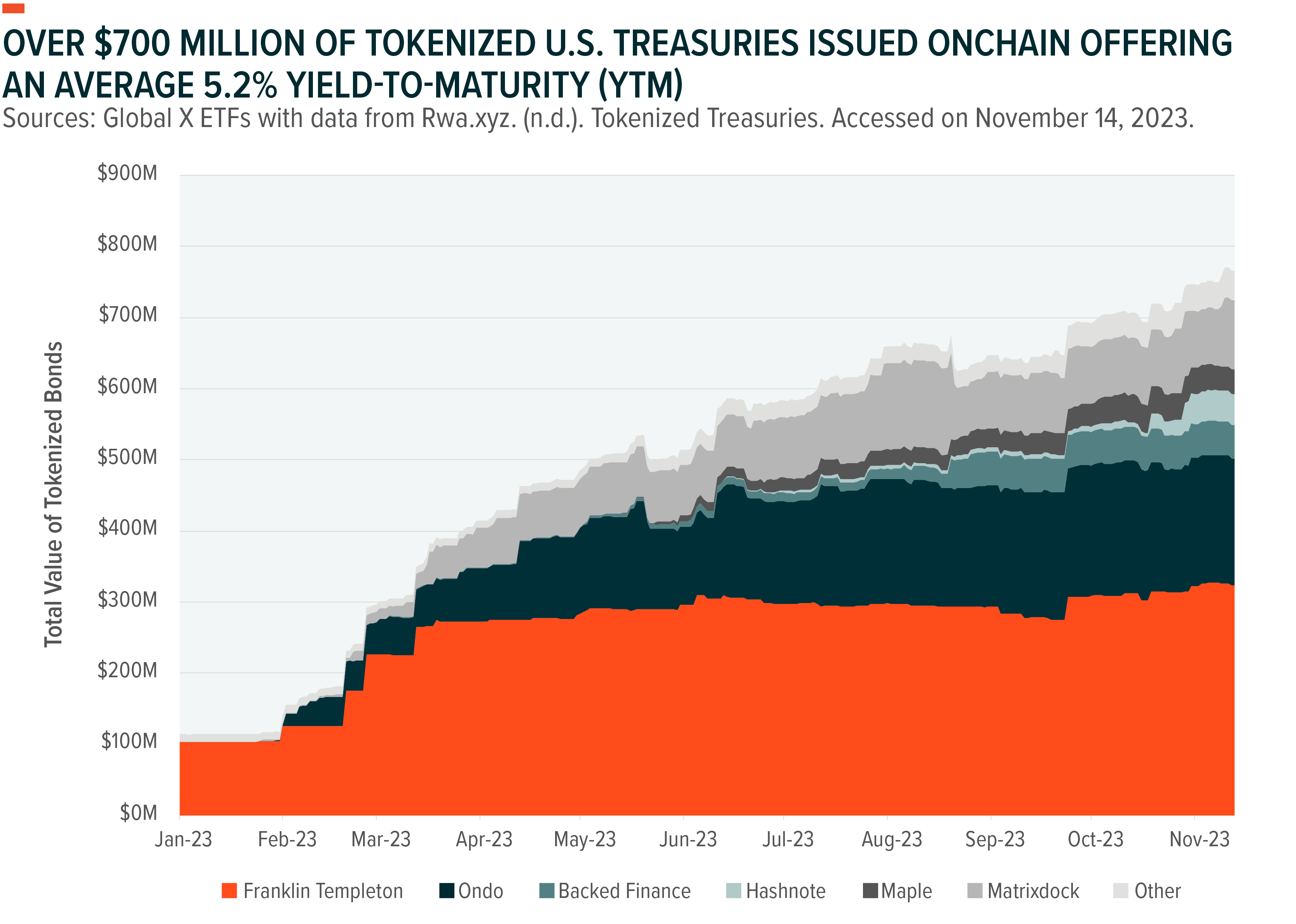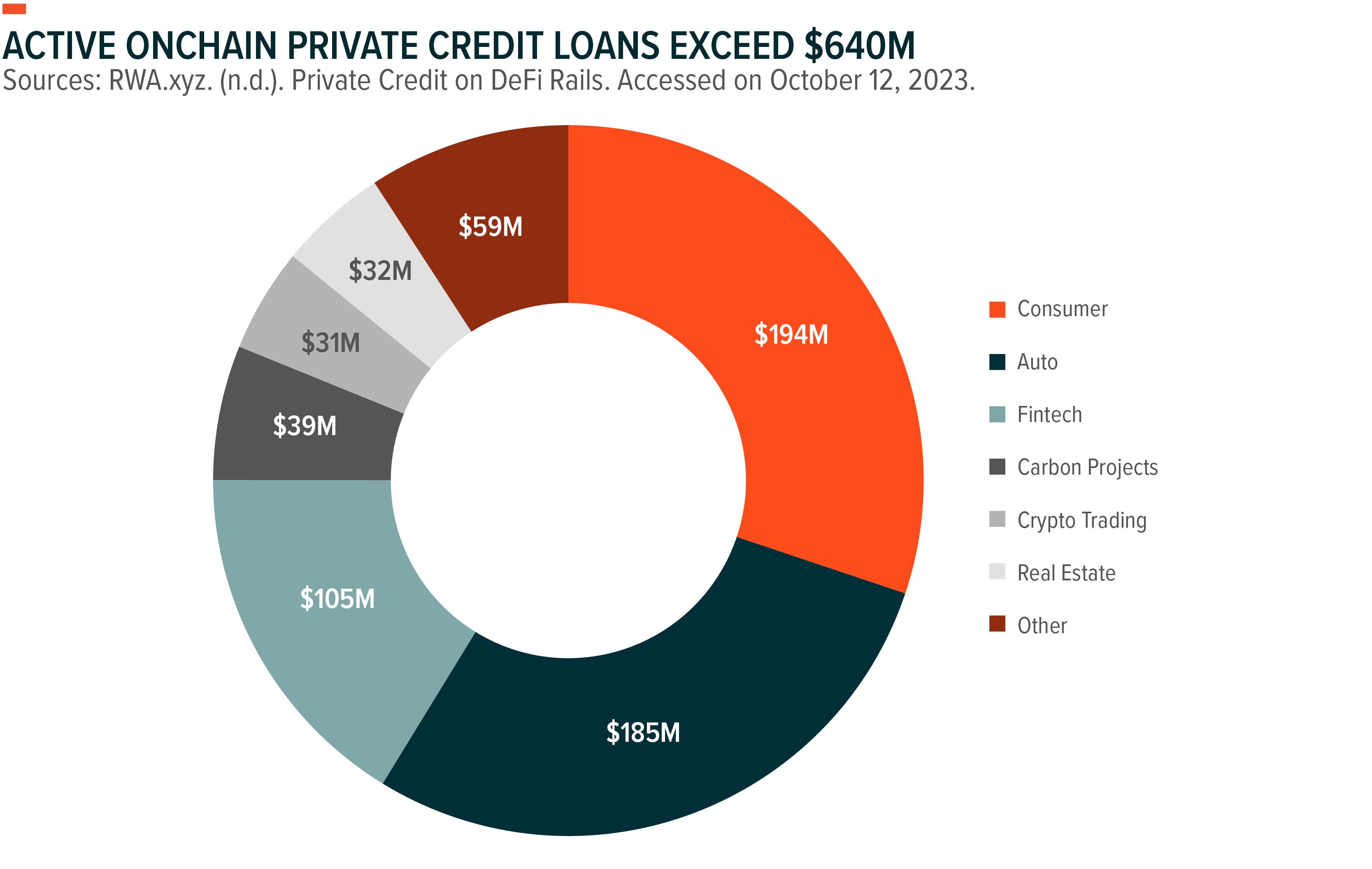Public blockchains popularized the concept of value tokenization, which initially garnered attention for facilitating the trade and management of assets such as digital art and property. It was only a matter of time before tokenization made its way to financial assets, a process that found momentum in 2023.
We believe that early tokenization of fixed-income securities such as U.S. Treasury bills (T-bills) and private credit loans is an emerging trend and a potential foundation upon which financial markets could extend to and expand blockchain rails.
This piece is part of a series that dives deeper into this year’s iteration of our flagship research piece, Charting Disruption.
Key Takeaways
- The market for tokenized bonds is expected to grow from under $1 billion today to approximately $1 trillion by 2030.1,2
- The tokenization of securities like T-bills is representative of ongoing experimentation that is seeking to leverage the capabilities of blockchains to modernize traditional financial rails.
- Private credit loans are an emerging market for tokenization, given their potential to facilitate access to financing opportunities for businesses and entrepreneurs around the globe.
Yield Dynamics Accelerating Exploration of Tokenized T-Bills
2023 was a year that saw investors take advantage of the highest yields on T-bills in more than a decade. Coupled with a general decline in liquidity and low demand for leverage across DeFi protocols, bringing high-yielding T-bills onchain emerged as a compelling opportunity.
What has resulted are several onchain permissioned applications strategically positioning themselves to capitalize on this opportunity. Today, tokenized T-Bills allow vetted onchain investors to access these attractive yields in a blockchain-native format.
The market for tokenized T-bills experienced remarkable growth between January and November 2023, surging over 600% to reach a value of approximately $700 million.3 With projections for the tokenized financial asset market to reach $4 trillion by 2030, with tokenized bonds accounting for approximately $1 trillion, the experiments taking place today represent the earliest forays into defining the standards that may govern securities issuance in the future. 4,5

In its current rudimentary state, tokenized T-bills are managed using an internal ledger for processing transactions into and out of the underlying assets. The documentation of token ownership, meanwhile, is a fully onchain process. While the current process of managing tokenized T-bill funds is not fully onchain or automated, blockchains are currently being used to provide operational leverage to the fund management process.
For the full benefits of tokenization to be realized, T-bills and other financial assets will need to be issued according to universal standards that are compatible with blockchain infrastructure. While this is not expected to occur in the short term, we do anticipate institutional experimentation of tokenization to accelerate from here.
During this development phase, participants are likely to discover the significant benefits that can result from making financial assets compatible with blockchain networks including allowing these assets to serve as highly efficient and universally accepted collateral across a range of financial and non-financial applications, ease of transfer and exchange, creative utilization of yield such as in self-repaying loans, and more.
Tokenized Private Credit Can Open Doors to More Efficient and Accessible Financing
The demand for onchain tokenized private credit loans steadily increased throughout the year as well, reaching a total active loan value of over $600 million as of October 2023.6 According to one estimate, tokenized private credit loans are active in eighteen countries outside the U.S. Financing for projects spans numerous industries already, including fintech, automotive, and carbon initiatives.7

Onchain private credit loans provide certain efficiencies compared to DeFi’s over-collateralization model. Specifically, these loans can use a mix of offchain assets and business income as collateral, significantly increasing the capital efficiency of loans, extending credit to underserved populations, and providing investors with increasingly diverse yield opportunities.
Blockchain technology and smart contracts play a pivotal role in automating tasks and optimizing operations in lending liquidity pools. More specifically, tokens are used to enable multiple purposes, including representing ownership rights of offchain assets on the blockchain, reflecting liquidity provided and a lender’s claim to the loan principal and accrued interest, and facilitating governance of protocol operations, such as determining lending pool risk parameters.
Conclusion: Financial Asset Tokenization Emerging
We anticipate a surge in efforts to enhance efficiency and opportunities within bonds, private credit markets, and other financial assets, driven by asset tokenization. Among the many potential benefits of financial asset tokenization, we highlight the dual effect of democratizing access across financial markets while expanding the adoption of blockchain technology. Should experimentation across asset tokenization yield the results that are anticipated, global financial markets may stand to make exponential gains in capital efficiency in the future.
 Global X Research Team
Global X Research Team